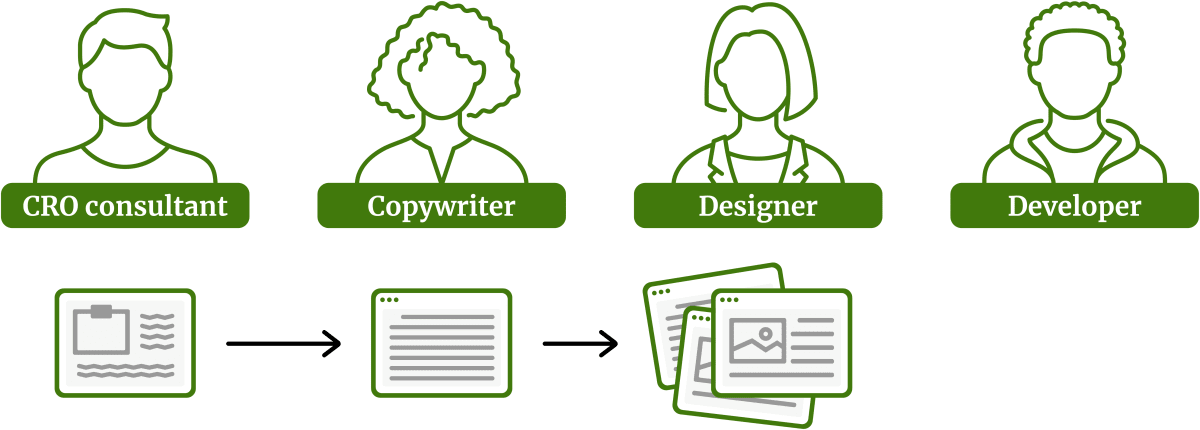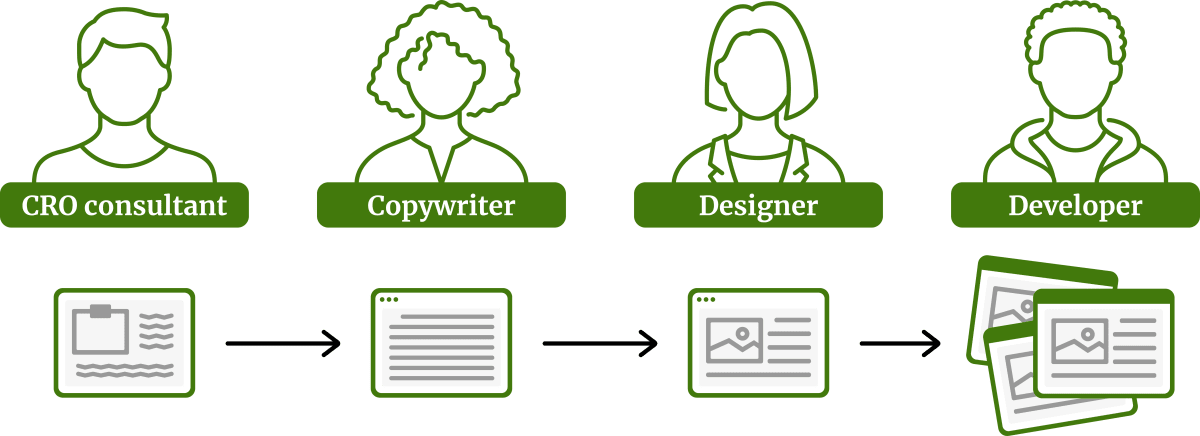The Theory of Constraints: How we relentlessly improve our productivity
Published: September 2023

Goldratt was an Israeli process engineer and consultant. We’re long-time fans of his 1984 business novel, The Goal, which popularized the Theory of Constraints, and three ideas every business should understand and internalize:
- No process can move faster than its slowest stage (the bottleneck or constraint).
- That one bottleneck constrains the entire process.
- Once you’ve identified the constraint, focusing on any other activity that doesn’t fix it is irrational.
Although Goldratt developed his theories for manufacturing—see this excellent article from our client, Vorne Industries— we’ve applied his ideas to ourselves and many other service businesses. In particular, we value the five-step process for finding and overcoming (or “breaking”) a bottleneck.
Step 1: Identify the bottleneck
You might assume that identifying bottlenecks is easy. Often, it is. If you’ve read our article on How the world’s best companies build unbeatable focus, you may remember the overworked designer with work piling up in front of her.

A “traffic jam” is a clear sign of a process problem, but bottlenecks can also exist within machines, policies, clients, and suppliers. Successful companies go to the real place and ask questions:
- Where is work “piling” up?
- What’s slowing us down?
- What would help our process flow faster?
You may find multiple issues in a particular process, but remember that there is only one true bottleneck at any time. Focus on it before you work on anything else.
Step 2: Exploit the bottleneck
When we find a bottleneck, we start by looking for easy ways to improve productivity:
- Continuous operation—Is 100% of the designer’s time spent on the bottleneck work, or is she delayed by unnecessary meetings, requests to “rustle up” marketing material, or other distractions?
- Reduce requirements—Apply 80/20 thinking to the designer’s work. What’s really important? Can we reduce—or even better, completely remove—some of her workload?
- Quality check—Is the designer getting exactly what she needs to work efficiently, or is the previous step in the process providing low-quality work? For example, is she forced to act as a spellchecker for poorly proofed copy?
- Equipment and maintenance—Does the designer’s equipment need updates or maintenance? Perhaps her computer is slow, or her software is old. (If so, fix it, but ensure that the IT team does the work out of hours.)
- Offload—Are other team members trained to take over tasks when the designer is busy, on vacation, or sick? Can freelancers add capacity when the pressure is on?
Before anything else, Step 2 ensures that the bottleneck can fully focus on the right activity.
Step 3: Subordinate everything to the bottleneck
If someone is a bottleneck, those around them often have “excess capacity,”—which is management speak for sitting around drinking Pumpkin Frappuccinos.
This is good.
In Step 3, we must ensure that the “upstream” and “downstream” parts of the process are always ready to serve the bottleneck.
In our example, this means that the copywriter should always be ready with the designer’s next project, and the developer should always be ready to receive the designer’s finished work. And if that means they are sitting around waiting for her, so be it.
Feels wrong, doesn’t it? But remember… nothing else matters until the design bottleneck is fixed. That’s the only way to increase productivity. Everyone else—including the copywriter, developer, and CRO consultant—must bow to that logic if the business is to grow.
Step 4: Elevate the bottleneck
If steps 2 and 3 haven’t fixed the bottleneck, it’s time to take more serious action.
As a note, it’s amazing how often companies jump right to this step, “fixing” poor processes by drowning them in money or resources. Increasing investment should never be a knee-jerk solution, but if the bottleneck is fully exploited and supported… perhaps it’s time.
In our design example, useful investments might include:
- New equipment—a faster computer or a better screen.
- A “better” designer—perhaps someone who is faster or more familiar with the software.
- Additional designers—who can bolster the team.
Whatever the “investment,” its goal is to elevate the bottleneck’s throughput until it is no longer a constraint on productivity and growth.
If you diligently pursue steps 1-4, you will inevitably “break” your bottleneck. Congratulations… but don’t stop now. The next step is the most important.
Step 5: Start again
Although we talk about “breaking” bottlenecks, the truth is they don’t break. They move.

The moment we broke the design bottleneck, something else became the slowest part of our process. Perhaps the copywriter is unable to service the upgraded “design department.” Perhaps the developer now has more work than he can cope with.
What should we do?
The answer—of course—is to return to Step 1.
There’s always a bottleneck somewhere in the system, and it’s always constraining our ability to grow. This can feel disheartening, but really it’s liberating. Companies that break one bottleneck increase their productivity one time; those that learn to do it regularly supercharge their growth.
Beware the voice in your head
At the start of this article, we described the Theory of Constraints as simple and powerful. But like many great ideas, it also seems kind of… obvious.
Don’t be fooled.
Successful businesses don’t discount “simple” ideas; they relentlessly test, execute, and repeat them.
How much did you like this article?
What’s your goal today?
1. Hire us to grow your company
We’ve generated hundreds of millions for our clients, using our unique CRE Methodology™. To discover how we can help grow your business:
- Read our case studies, client success stories, and video testimonials.
- Learn about us, and our unique values, beliefs and quirks.
- Visit our “Services” page to see the process by which we assess whether we’re a good fit for each other.
- Schedule your FREE website strategy session with one of our renowned experts.
Schedule your FREE strategy session
2. Learn how to do conversion
Download a free copy of our Amazon #1 best-selling book, Making Websites Win, recommended by Google, Facebook, Microsoft, Moz, Econsultancy, and many more industry leaders. You’ll also be subscribed to our email newsletter and notified whenever we publish new articles or have something interesting to share.
Browse hundreds of articles, containing an amazing number of useful tools and techniques. Many readers tell us they have doubled their sales by following the advice in these articles.
Download a free copy of our best-selling book
3. Join our team
If you want to join our team—or discover why our team members love working with us—then see our “Careers” page.
4. Contact us
We help businesses worldwide, so get in touch!
© 2025 Conversion Rate Experts Limited. All rights reserved.










